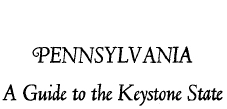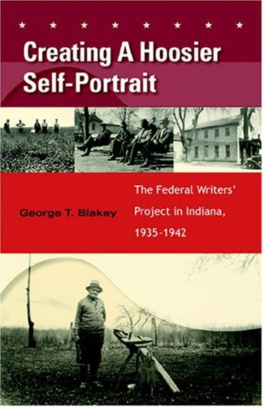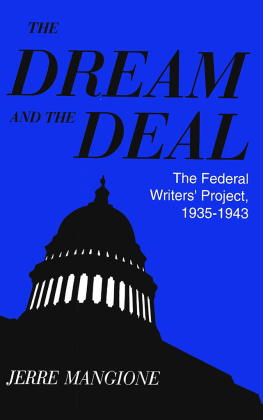


Published in 2014 by Trinity University Press
San Antonio, Texas 78212
www.tupress.org
This book was first published as part of the Works Progress Administrations Federal Writers Project, a United States federal government project to fund written work and support writers during the Great Depression. It has been published in various editions, but this edition replicates the original. Trinity University Press is proud to make these books available through the WPA Guides to America Digital Library.
978-1-59534-236-2 ebook

T HE Commonwealth of Pennsylvania has a rich offering to display to those who seek to know America. Its natural resources, its scenery, its people and their manifest interests illustrate a vivid section of the contemporary life of the Nation. But there is more to be discovered than the life of today and its conditioning environment. There is the past, and in few regions on this continent is there as much of the significant past preserved in proximity to the vibrant present.
It is an interesting adventure to review that past, to make an inventory of the Commonwealths successes, its failures, its triumphs, and its disappointments during the three centuries since white men first crossed its threshold. Here are presented the highlights of mans accomplishments within the Commonwealth from early days to the present, together with descriptions of those spots which nature, man, and retrospect have made interesting and important.
So rich a treasure house cannot be best explored in ignorance or under the inspiration of whim or vagrant fancy, so those who know the State have sought to share their knowledge. This volume has been written by citizens of the Commonwealth for their neighbors, and to their neighbors within and without Pennsylvania they offer it.
ROY F. NICHOLS
University of Pennsylvania
Philadelphia, Pennsylvania
June 27, 1940

I T HAS become a trite saying that Pennsylvania Has Everything, but the difficulty has been that few people know where to find it. Pennsylvania: A Guide to the Keystone State is the most valuable aid to seeing and knowing Pennsylvania yet made available to the general public. The historic and scenic treasures of the Keystone State are here located and charted definitely and accurately as never before.
This volume, probably not without error despite the careful reading of numerous consultants, cannot be expected to tell all that might be written on the historic heritage of the Commonwealth or the contemporary scene. That would take several volumes. But here are the highlights of Pennsylvania. From its pages emerge new bits of information as to our role in making modern America. New sites and vistas are opened for the inspection of the tourist; old ones are called to mind more fully.
The Guide is a valuable and interesting book. It should be a contribution to better citizenship through making Pennsylvanians conscious of their traditions and backgrounds. In these troubled times such a work may well aid in the preservation of those fundamental values so essential to the maintenance of our democracy.
S.K.STEVENS
State Historian
Pennsylvania Historical Commission
Harrisburg, Pennsylvania
July 3, 1940

W ITHIN the boundaries of what is now this great Commonwealth, where a handful of Swedes for forty years had lived in peace and friendship with the Indians, William Penn, the English Quaker, laid the foundations of an experiment in government that might well be termed a well-spring of modern democracy.
Here, from the four corners of the earth, came people of numerous racial groups and creeds with their different cultures, customs, and tongues. In Pennsylvania there existed no relentless policy of Indian extermination, no exiling of religious dissenters, no witch burning, no widespread traffic in slaves, no barriers of race, religion, politics or class to keep courageous hearts and willing hands from attaining security, freedom, and happiness.
Today the descendants of the first pioneers, together with those of later immigrants who sought the opportunities afforded free men, have grown to more than ten millions. They enjoy that priceless heritage and are living witnesses to the fulfillment of those concepts and ideals.
Is it not fitting, therefore, that such cherished shrines as Independence Hall, the Nations birthplace; Valley Forge, where the cause of liberty lived through its darkest hours; and Gettysburg, where the Union survived its greatest wound; should all rest within the borders of Pennsylvania?
This volume, one in an extensive series of guides to the American scene by the WPA Writers Program, relates this story of the Keystone State in addition to serving as a conventional guidebook. It was begun by the Pennsylvania Unit of the Federal Writers Project under the supervision of Paul Comly French; final writing, research, condensation, and editing was completed by this Project sponsored by the Pennsylvania Department of Public Instruction. The Pennsylvania Historical Commission acted as co-sponsor in its preparation, and the University of Pennsylvania served as co-operating sponsor to publish.
While space precludes listing all past and present workers on units throughout the State who have contributed to its preparation, credit for long and thorough research is due Charles Bomze, Clyde Portlock, and Samuel Schaeffer. Major contributions to the text were made by Katherine Britton, Irving Ignatin, George Lucey, Samuel Putman, and James Tighe. Tours were road-checked by Elmer W. Cloud, George B. Reeves, Joseph Schulhoff, and Jacob Silverstein. Architectural descriptions were supplied by Richard Fernbach and Thomas Wharton. Charles V. Waters served as copy reader for all manuscripts, and Joseph A. Kilcullen as production consultant. A list of other consultants will be found in the acknowledgments.
The book was edited by Grant M. Sassaman, with James M. Moore as editor of the tours section. All maps were prepared by staff cartographers under the direction of William J. Hagerty.
As the Guide went to press before the 1940 census figures were available, the 1930 figures are used throughout the text. There is, however, an alphabetical list of the preliminary 1940 figures in the Appendices.
C.C.LESLEY
State Supervisor
Pennsylvania Writers Project
September 1, 1940

Contents

Illustrations

Next page






